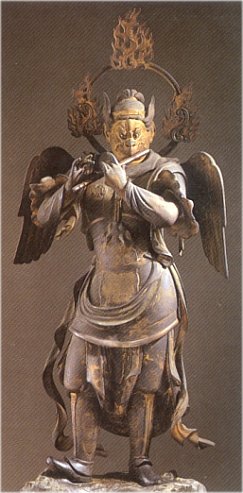Karura
- See also :
- See also :
Karura 迦楼羅,
Karura-Ō 迦楼羅王 (Skt. = Garuda)
Bird of Life, Celestial Eagle, Half Bird Half Man

)
Karura 迦楼羅
Sanskrit = Garuḍa (the Devourer), Chinese = Jiālóuluó
Japanese = Karura, Korean = 가루라, Tibet = Khyung
A mythical bird-man creature of Hindu lore who was later adopted into the Buddhist pantheon as a protector deity. The gold-colored Garuda (Skt.) has a human body but the wings, face, and beak of an eagle-like bird. In early Hindu literature, Garuda is granted immortality by Lord Vishnu and serves as Vishnu’s mount (avatar). In Tibetan tradition, Garuda is a mythical bird, similar to an eagle, but of gigantic proportions, able to block the sunlight with its size. In Japan, Garuda is an enormous fire-breathing eagle-man with golden feathers and magic gems crowning its head. Garuda’s various attributes are:
- Personifies the blazing rays of sun, the wind, and the esoteric teachings of the Vedas (Indian texts of sacred knowledge).
- Fierce bird of prey, variously described as an eagle, hawk, or kite. Can spew fire from mouth; flapping of wings sounds like clap of thunder.
- Mortal Enemy of the naga, a Hindu group including serpents & dragons. Karura feeds on the naga.
- Only naga who possess a Buddhist talisman, or naga who have converted to Buddhism, can escape from the naga-eating Karura. <Source: Flammarion>
- Karura’s hatred of the naga stems from an ancient feud between Karura’s mother (Skt. Vinata) and her sister (the mother of the naga).
- First to teach mankind how to cure snake poison.
- In Vedic and Hindu mythology, Karura steals the nectar of immortality from Indra in order to gain the release of his enslaved mother. The pot of nectar is eventually returned to Indra, on condition that Indra grant Karura permission to feed on naga.
- In the Purana (religious texts of ancient Hindu myths), Karura accidentally drops the bile of a slain Ashura; the bile falls to earth where it solidifies into veins of emerald. This story sparked the belief that touching emeralds neutralizes any poison.
- In Southeast Asia the walls of temples are often decorated with Karura, as at Angkor and Java
- Carries the sacred Nyoi Hōju 如意宝珠 (Chn. = Rúyì 如意) jewel on its neck. This pearl is said to grant every wish and remove every suffering. According to legend, this jewel emerged from the head of the dragon king 竜王. <Sources: JAANUS and Digital Dictionary of Chinese Buddhism>
- Garuda is sometimes translated into English as griffin. <Source: Digital Dictionary of Chinese Buddhism; sign in with user name “guest”>
- In Japanese art, Karura is depicted as an ornate bird with human head; sometimes shown treading on serpents or holding serpents. Karura does not appear often in Japanese Buddhist sculpture, and is rarely the object of central devotion.
- In Japanese art, Karura is one of the 33 Manifestations of Kannon Bodhisattva. See photo below.
- Like the Phoenix, Garuḍa is associated with fire and serves as a symbol of flame (said to represent the purification of the mind by the burning away of all material desires). In Japan, the term Karura-en 迦楼羅焔 refers to the flames spewed from Karura’s mouth, while the term Karura Enkō 迦楼羅焔光 refers to the feiry halo (kaen kōhai 火焔光背) often attached to statues of Fudō Myō-ō. Some say Fudō’s customary flame halo originated from the vomit of Karura, while others say the halo resembles Karura’s outstretched wings. Karura’s head is sometimes depicted on Fudō’s halo as well. <Source: JAANUS>
- There is a great deal of confusion about Karura and the mythical Phoenix. Many web sites refer to the Karura as Phoenix, and vice versa, but this is wrong. The two are different mythical creatures.
- Garuda is the national symbol of both Thailand and Indonesia. The national airline of Indonesian, moreover, is named Garuda Indonesia.